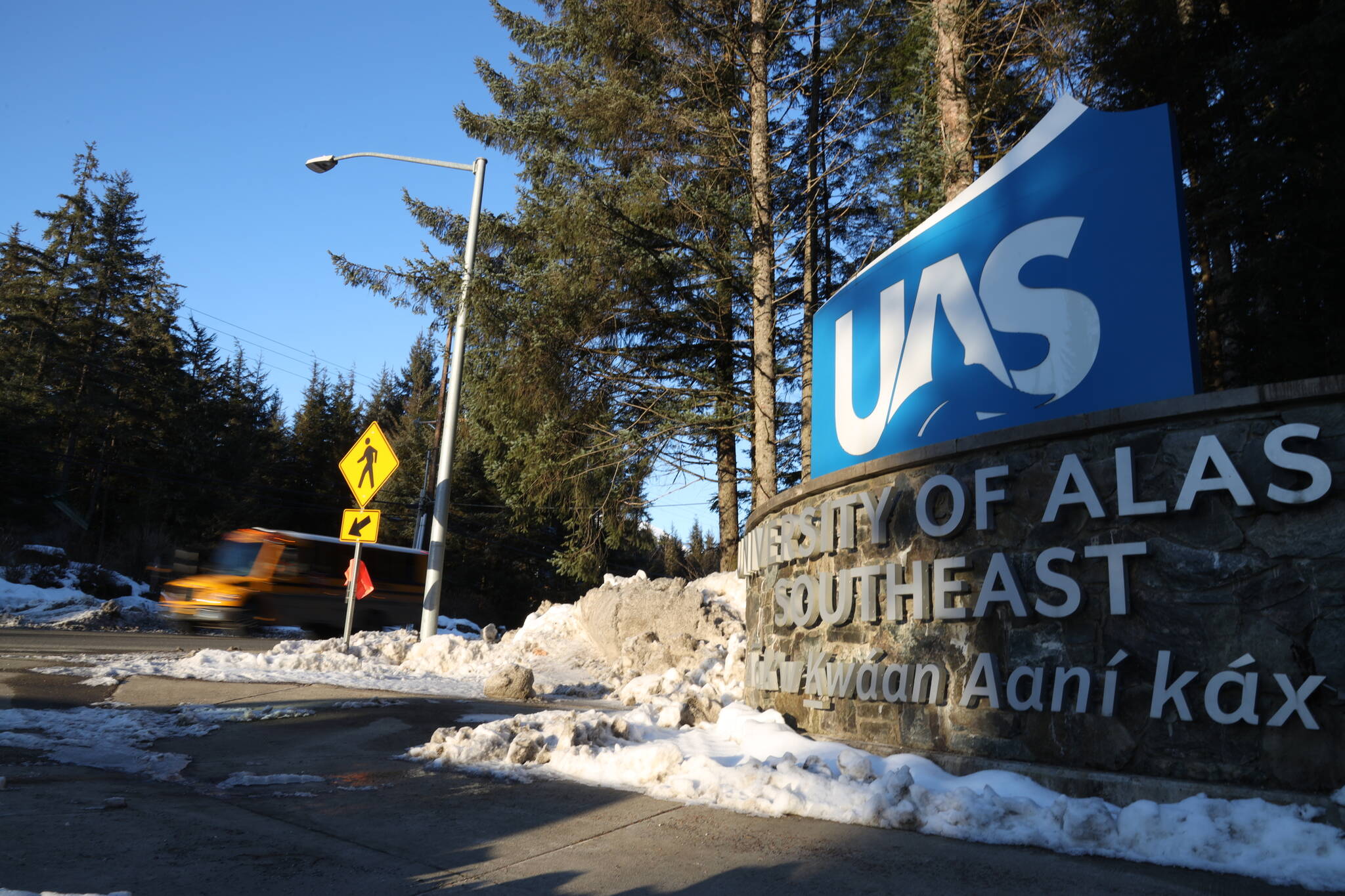An optimistic theme of finances and student enrollment rebounding from tough times — with a “yes, but” about staffing shortages having critical impacts statewide – was expressed by University of Alaska President Pat Pitney during her “State of the University” address Tuesday before an audience of business leaders in Fairbanks.
“I’m thrilled to share the University of Alaska has turned the corner,” she said in a line getting widespread applause. “We have fiscal stability for the first time in nine years and (as of) this spring a growing student body. And very exciting news — last year we reached the highest-ever level of externally funded research. We are about to eclipse that record again this year.”
Pitney also spent much of her 30-minute speech focusing on future-looking topics such as efforts to increase retention and subsequent in-state employment of students, and projects such as a drone program she said could make Alaska the first state with a commercial unmanned vehicle industry.
Mindful she was speaking to Fairbanks Chamber of Commerce, Pitney acknowledged “I know some of you are frustrated by our inability to respond to your workforce needs.” But she also used the speech to highlight efforts to university is making to ensure more students graduate and pursue careers in Alaska — and how partnerships with businesses can help.
One of several specific examples she cited was Carl Doutt, who became a dual enrollment student at the University of Alaska Southeast while still attending high school in Juneau, taking advantage of a scholarship from Hecla Greens Creek Mine.
“He took an introductory course on mining occupations and operations that included a tour of Greens Creek and a comprehensive overview of Alaska’s mining industry,” Pitney said. “He then enrolled in UAS’ mine mechanic associates program and secured an internship at Greens Creek for the summer of 2021. He graduated from UAS last year, and now works full-time at the mine. Carl was almost fully supported during his time at UAS — thanks to the industry.”
Citing recent state statistics regarding the workforce shortage, Pitney noted “about 25% of students who go out of state for college come back and stay in Alaska long term.” As a result there are 25,000 fewer working-age adults in Alaska than a decade ago, resulting in acute shortage in industries such as teaching, health care and construction — and the university system, which has about 1,500 fewer faculty and other staff compared to when its financial woes began nine years ago.
”Our universities are a big part of the solution to meet those workforce needs,” she said. “Over the last 10 years, we’ve awarded over 44,000 degrees and certificates – 72% of them in Alaska’s highest-demand employment fields. Eighty percent of our graduates are working here in Alaska within a year after graduating.”
In contrast to past years when top university officials have had harsh words for Alaska politicians responsible for budget and program cuts, Pitney was largely complimentary toward both state lawmakers as well as the congressional delegation. She praised U.S. Sen. Lisa Murkowski and Alaska Gov. Mike Dunleavy, among others, for helping to to pass the University of Alaska Fiscal Foundation Act, which will allow the university to triple its land holdings to more than 500,000 acres.
“We won’t be able to monetize that land overnight,” Pitney said. “It will take years. But we finally have the path.”
The address came a day after she and other top university officials offered a more in-depth overview of the university’s situation to the state Senate Education Committee. Pitney emphasized that not “grappling with major state budget reductions” for the first time in years has been critical to more than just the university’s being able to balance its budget.
“With that financial stability has come focus and the ability to promise students their programs are going to be there and the ability to promise students that their financial aid is going to come through,” she said. “That confidence to our students is absolutely essential. It doesn’t take a ton. It just takes stability, that it’s there and it’s not going to be gone tomorrow.”
Among the efforts during the current legislative session Pitney singled out is House Bill 31 by state Rep. Andi Story of Juneau that increases amounts awarded through the Alaska Performance Scholarship program as well as eligibility among the state’s high school students.
“Keeping them in state in the first place is a really good strategy for our workforce,” Pitney said. “Doing the small tweaks on the Alaska scholarship program will make a huge difference in how many students we can attract to the University of Alaska, and the more students we attract to the University of Alaska the more workforce the state has.”
Other measures the university is considering include not relying on tests such as the SAT or ACT for admissions, since during the COVID-19 pandemic when the tests weren’t administered “the people who (enrolled) were equally successful whether the tests were taken or not taken,” Pitney said. Also, she’s hoping performance scholarships will be made official sooner than the current date of August following graduation.
“We need to make that the fall coming into their senior year so they can have that certainty about where they’re going to go to college,” she said.
During her speech and committee presentation, Pitney also highlighted efforts where she feels Alaska can be unique or groundbreaking in its university programs, including a drone research program now underway at the University of Alaska Fairbanks that she said could make the state the leader in industrial use of the devices.
“It would change our landscape if we have unmanned planes flying freight, flying fuel, doing searches in a search and rescue situation, monitoring wildfires, monitoring the pipeline, counting animals, counting fish for our Department of Fish and Game,” she told the committee. “It changes the economic equation. We can have Alaska be a place where we try out this commercial industry in a very safe way.”

